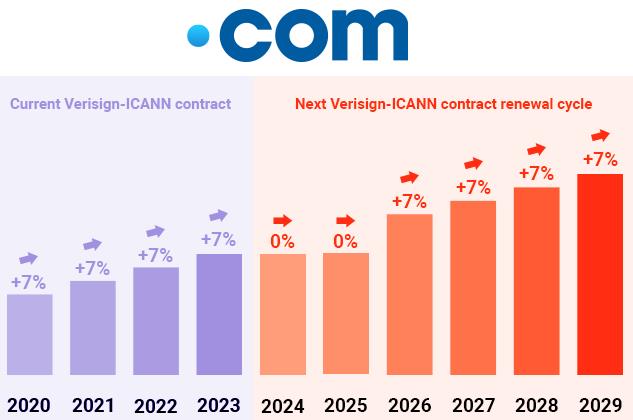Prices are rising for .com domains. In February this year, after 8 years, ICANN announced the first step to increase the price of .com domain. Verisign has confirmed the price increase. The price increase will be reflected in the market from September 1, 2021.
ICANN contracts with a company called Verisign to administer all .com domain registration services in the world. ICANN and Verisign have made some changes to their agreement, which will allow Verisign to increase the cost of the .com domain by up to 70% in the next 10 years.
The current minimum cost for a .com domain registration and transfer is 7.75 USD. After the price increase, each domain registrar will have to pay 8.39 USD for each .com domain. The chart published by ICANN shows that by 2023, prices will increase by 7% regularly. In the next two years (2024 and 2025) that price will remain the same. After that Verisign will be able to increase the price again and it will be up to 7% every 3 years till 2029.
If this continues, by 2025, each registrar will have to register or transfer the .com domain at an increased price of about two and a half dollars. And after 10 years, the price will rise to 13.50 USD.
ICANN does not increase the value of domains: these are from an agreement between Verisign and the U.S. Department of Commerce, which oversees certain aspects of the .com domain. Verisign reached an agreement with the US government in 2018 to increase prices. But it is now attracting attention as ICANN is close to confirming the price increase in its own deal with Verisign.
The government agreement justifies the price increase by saying that new top-level domains (such as pizza and cameras) and “social media use” have made the domain name market “more dynamic”. The price increase is not wrong, because .com still remains the supposed extension for the domain. At least in the United States.
As Engadget noted, the change also stems from the Trump administration’s desire to bring back something Obama-related from afar. In a 2018 press release on updated contract changes, the Department of Commerce’s telecom agency referred to price stability as “Obama-era price controls” and said it rejected them in favor of “price flexibility.”


Comments